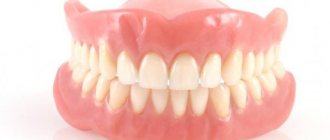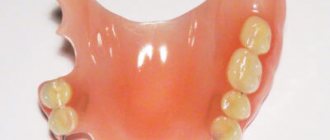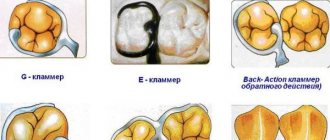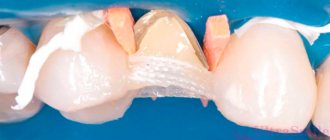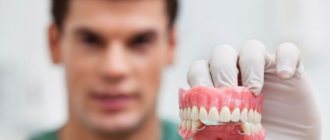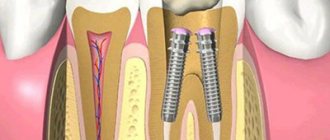From this article you will learn:
- What is an implant
- Pros and cons of implants
- Types of implants
- Installation methods
- Rehabilitation and rejection after the procedure
- Implant failure - what to do in this case
- Contraindications
- Questions and answers?
Losing a tooth relieves pain and inflammation, but gives rise to other problems. The chewing process is disrupted, and displacement of molars and premolars may begin. Therefore, it is necessary to restore the integrity of the dentition. Installing dentures and bridges is inconvenient and not always possible. Implants combine convenience, reliability, safety and guarantee a beautiful smile.
What is an implant
A dental implant (implant) is an artificial multi-component structure that is installed into bone tissue. After fusion, crowns are fixed to it. In simple terms, an implant is an artificial root that performs all the functions of a lost tooth.
A dental prosthesis is implanted into bone tissue. Then an abutment (periosteal element) and a crown are mounted on it.
Dental implant
Indications for installation are partial or complete edentia, restoration of lost incisors, molars, premolars and canines.
What is dental implantation?
Dental implantation involves the implantation of artificial roots into bone tissue, onto which a prosthesis or crown is subsequently attached.
The dental implant itself is a kind of screw (rod) that is immersed in the bone, acting as a tooth root. Dental implants have a diameter of 3 to 5 mm; titanium and zirconium oxide are most often used as materials for their production. The main property required of materials for dental implants is biocompatibility with human tissue. They should not cause the development of allergies and rejection reactions: otherwise, the operation will be ineffective and can lead to serious complications if assistance is not provided in a timely manner.
Dental implantation, when performed correctly, has very low risks associated with complications during the operation and the postoperative period. The protocols used in practice, medical equipment meets all standards of quality, reliability and safety. If you follow the technique of all stages, the rules of asepsis and antisepsis, and the absence of contraindications, implantation is the most accurate and reliable method of restoring both a single defect and the entire dentition.
Pros and cons of implants
Installation of pins in bone tissue requires the experience and practical knowledge of a maxillofacial surgeon and implantologist. And fulfillment of all his prescriptions by the patient. In addition, before implantation, the oral cavity is sanitized and any inflammatory processes are stopped.
| pros | Minuses |
|
|
Table. Advantages and disadvantages of implants
The prevalence of pathologies of the dental system, such as partial and complete absence of teeth, causes a high need for dental prosthetics among patients of working age and amounts to up to 52% of cases.
Most often among the defects of the dentition there are unilateral, bilateral distally not limited defects, long-term defects and complete absence of teeth. Orthopedic treatment of such defects using traditional prosthetic methods does not meet the increasing demands of patients.
Prosthetics with removable denture designs in many cases do not satisfy patients, especially young people. According to a number of researchers, up to 26% of patients do not use removable dentures.
In almost half of the cases, removable dentures are poorly fixed (mobility during chewing is determined). Of all patients who seek orthopedic care, 86% prefer fixed denture designs.
Over the past 25 years, dental implantology has occupied an important place in domestic dentistry. The development of this direction becomes possible thanks to advances in the field of materials science and biomechanics, as well as as a result of studying the patterns of biological interaction of implants with surrounding tissues.
At the moment, dental implantation is characterized by high efficiency and a significant range of possibilities, both in replacing defects in the dentition and in the rehabilitation of patients with complete absence of teeth.
Orthopedic rehabilitation of dental patients using dental implants is often limited and accompanied by difficulties.
First of all, this is the close location of important anatomical structures, namely the maxillary sinus, nasal cavity, and neurovascular bundle of the mandible.
According to statistics, complex anatomical location occurs in 30-35% of cases, so the use of dental implants does not always lead to sustainable guaranteed success. The probability of unsatisfactory results, according to reports by various authors, varies from 6% to 50%.
Long-term absence of teeth causes secondary disorders of the dental system:
- Alveolar process atrophy
- Secondary occlusal deformities
- Pathological changes in the temporomandibular joints
- Changes in the volume of the maxillary sinus and others.
Therefore, dental implantation in the lateral parts of the upper jaw is often difficult as a result of significant atrophy of the alveolar processes of the jaws.
Dental implantation as a method of orthopedic rehabilitation of dental patients remains one of the leading methods for replacing dentition defects. It is aimed not only at restoring chewing function, but also at obtaining a high predictable result of orthopedic rehabilitation.
At the present stage, experts in the field of dental implantology focus on minimizing the duration of osseointegration through the latest implant systems that have osteoconductive properties, and by creating favorable conditions for rapid osseointegration.
Features of dental implantation in difficult anatomical conditions
Optimization of the surgical stage of dental implantation as an important stage in preparing the patient for prosthetics significantly improves the quality and efficiency of rehabilitation and makes the result more predictable and predictable.
We will try to consider aspects of the use of dental implantation in complex anatomical and topographic conditions. Studying the characteristics of the state of the surrounding tissues in the implantation site, optimizing the reparative regeneration of bone tissue, the interaction of various proteins and their ratios, the dynamics of the tissue response to the implant substantiate the need to develop an optimized algorithm for the surgical stage of dental implantation.
Let's get acquainted with the placement of implants in anatomical supporting structures.
Inclined implants
Dr. Krekmanov and colleagues in the original study placed 138 implants on 22 atrophic alveolar ridges of the maxilla. Forty of these implants were installed with an inclination towards the sinus.
After 6 months, the implants were opened, followed by the manufacture of fixed denture structures. After a four-year period of prosthetic function, 5 non-tilted and 1 inclined implants were lost, showing success rates of 92.5% and 95.7%, respectively.
The same authors, in another study, installed 75 implants in 22 atrophic maxillae. 54 implants were tilted, and 21 implants were installed in areas of the jaws with replanting of osteoplastic material.
Three inclined implants were lost without achieving osseointegration, and one was lost after loading. After 18 months, the success rate was 94.7%.
The authors proposed that the main advantages of inclined implants are a reduction in cantilever arm, increased corticalization, excellent primary stability, and long-term functioning of the implant.
Perales et al conducted a retrospective study on 25 patients with 101 implants, of which 59 were placed in the axial position and 42 in the oblique position.
All patients were rehabilitated with the manufacture of fixed dentures. After 33 months of follow-up, the success rate was 95.2% for inclined implants versus 91.3% for axial implants.
According to the report, 55.2% of complications were due to mechanical factors.
The authors concluded that the installation of inclined implants from a biomechanical point of view has a greater risk of complications - they are connected using a superstructure that acts like a rigid splint.
Another therapeutic option in the posterior maxilla is the placement of a pterygopalatine implant in combination with an anterior implant. This formation is formed by the posterior part of the maxillary bone and the frontal fragment of the vertical cortical plate of the palatine bone.
The pterygopalatine process has a strong cortical plate, which provides good primary stabilization of the implant.
Wolfinger et al reported the results of a study in which 356 implants were placed in the pterygopalatine process of the maxilla, combined with 1461 implants placed in the anterior region in 189 edentulous maxillae.
The success rate was 92.1% after a mean follow-up of 5 years. Of the 356 implants placed in the pterygopalatine process of the maxilla, 41 implants were lost due to failed osseointegration.
Other authors, including Vila Biosca, have critically compared the results of pterygopalatine implants with those of sinus lift implants.
Nocini et al presented a case report in which they described the placement of maxillary pterygopalatine implants using a modified osteotomy.
By placing the implants at a 20-degree angle, they adapted the modified osteotomy to the oral anatomy, thereby reducing the risk of injury to the lips or buccal mucosa while making the operator's job easier.
Limitations associated with alveolar bone atrophy and bone problems encountered with sinus lifts are pushing researchers to look for alternative methods of dental implantation.
Placing implants in the zygomatic bone is a relatively new technique that involves the placement of two implants on both sides, 35-55 mm in length, which, passing through a transsinus path, are firmly fixed in the zygomatic bone.
These implants are usually combined with at least two anterior implants and secured with a plate prosthesis.
Aparicio et al, based on a clinical series of 29 cases, described the main characteristics of this technique, the indications for its use, the surgical protocol and the clinical steps of prosthetic fabrication.
Parel published a retrospective study involving 65 implants placed in the zygomatic bone of 27 patients. After 6 years of follow-up, none of the implants were lost, the success rate reached 100%.
Stella and Warner described a variant of the technique that involves installing an implant, bypassing the maxillary sinus, along the contour of the malar bone with fixation in the zygomatic bone.
This approach eliminates the creation of a window in the wall of the maxillary sinus and facilitates the installation of the implant, placing it above the alveolar process in the area of the first molar, at a more vertical angle.
This dental implant technique has been used in patients with complete primary edentia as a result of genetic changes or syndromes.
Balshi and Wolfinger describe a case of rehabilitation of a 20-year-old patient with ectodermal dysplasia using two zygomatic implants combined with four implants in the anterior maxilla, avoiding any reconstructive surgery.
Augmentation of the maxillary sinus floor
This surgical technique is one of the most widely used in the rehabilitation of patients with atrophy of the alveolar process of the lateral parts of the upper jaw, from the point of view of the predicted final result.
The main purpose of this operation is to increase the thickness of the alveolar process in the area of the bottom of the maxillary sinus with atrophy of the alveolar process of the upper jaw, which makes it possible to install implants in the future.
This surgical procedure is a standard aseptic procedure that is performed under either local or general anesthesia.
When performing dental implantation, the doctor has to face difficulties that are associated with the anatomical and age-related characteristics of the jaws.
For an implantologist, installing a dental implant on the maxillary bone can be difficult due to atrophy of the alveolar process or the pneumatic type of structure of the maxillary sinuses.
To increase the height of the alveolar process, both in the lateral and frontal sections, various methods can be used:
- Lifting the floor of the maxillary sinus (sinus lift)
- Raising the floor of the nasal cavity (anthroplasty or anthro-lifting)
- Bone grafting (use of osteoplastic materials on the atrophied part of the alveolar process).
In case of atrophy of the alveolar processes of the jaws, both auto- or allo-bone and xenogeneic (Osteomatrix) in the form of bone chips, etc. are used as an osteoplastic material for bone augmentation and reconstruction of the alveolar processes.
Carrying out reconstructive operations to build up the alveolar process is carried out according to the standard rules of osteoplastic operations with different fixation of the implanted material.
Depending on the type, size and location of bone atrophy of the alveolar process, Tulan and Pataraya (2001) offer the following classifications of clinical forms:
- Anatomical varieties
: horizontal resorption (reduction in the thickness of the alveolar wall, which turns into a thin plate, while maintaining sufficient height), vertical (leads to loss of height of the alveolar ridge and is observed after traumatic extraction) and mixed resorption (simultaneous decrease in the height and thickness of the alveolar ridge).
- Topographical forms
: single (there is a deficiency of bone tissue in the area of one tooth, most often in the area of the incisors), segmental (found in the distal parts of the alveolar process) or complete (observed throughout the entire jaw).
A special place is occupied by planning the operation in the absence of premolars and molars, when the height of the lower wall of the sinus is less than 10 mm for installation of implants.
In this case, if the basic rules are not followed, when installing an implant in the area of a premolar or molar in the upper jaw requires a minimum bone height of 8-10 mm (especially in the immediate vicinity of the sinus), it is impossible to count on a positive result.
Based on the accumulated practical experience of domestic and foreign authors, similar cases of maxillary bone deficiency are divided into 4 groups.
First group
— the height of the alveolar process of the maxillary bone is 10 mm or more. Here it is possible to install dental implants using the usual method.
Second group
- the height of the alveolar process of the upper jaw is within 6 - 8 mm. In such cases, it is possible to use an 8 mm long implant and obtain bicortical fixation. After installation of a dental implant, sufficient primary stabilization is a prerequisite.
Third group
— the height of the alveolar process is from 5 to 7 mm. In such cases, a classic sinus lift operation is necessary. The floor of the maxillary sinus is raised by several millimeters so that the height of the alveolar process is 8-10 mm.
The resulting cavity can be filled with auto- or allo-bone, xenogeneic osteoplastic materials or bioceramics. An alveolar ridge height of 5-7 mm is a necessary condition for primary bone fixation of a dental implant on the alveolar ridge side.
Fourth group
— the height of the alveolar process of the maxillary bone is less than 4 mm. In such cases, the installation of dental implants is problematic due to the fact that it is not possible to provide even minimal primary bone stabilization of the implant.
At the first stage, it is recommended to carry out a classic sinus lift without installing implants, only filling the cavity with osteoplastic material (Osteomatrix).
The second stage is performed after 8-12 months: dental implants are installed. Unfortunately, in this group there is a high percentage of failures, and the main disadvantage is that the treatment period for patients increases by 3-4 times, that is, from one and a half to three years.
Based on what was said earlier and depending on the degree of atrophy of the alveolar processes, the classification proposed by Misch (1987) can be used. Depending on the severity of atrophy of the alveolar processes of the maxillary bones, the researcher divided the subjects into 4 groups.
According to the Cawood classification (1998), 5 classes of the condition of the maxillary sinuses can be distinguished depending on the amount of bone resorption of the alveolar process.
The operation of increasing the thickness of the alveolar process by raising the bottom of the maxillary sinus of the upper jaw is described in great detail by Boyne and James using autogenous bone material containing the actual bone and bone marrow.
Increasing the thickness of the bottom of the maxillary sinus in modern dental practice is carried out in two ways. This is the classic approach where the entrance to the maxillary sinus is achieved through the lateral wall, as described by Tatum in 1986. Or using the alveolar ridge approach developed by Summers.
With the closed method, increasing the thickness of the alveolar process causes great inconvenience due to the occurrence of concentrated pressure created by an osteotome or fragments of destroyed bone over a very small area.
Quite often this leads to perforation of the Schneiderian membrane. For this reason, the use of the method is limited to those clinical cases where it is necessary to raise the membrane by no more than 3-5 mm.
An attempt has been made to develop a technique not only for controlled, minimally invasive access to the maxillary sinus, but also for the careful removal of a large area of mucosa, providing an increase in Schneiderian membrane to 10 millimeters or more, in cases of significant bone deficiency.
Professor Benner's working group developed and introduced into dental practice a new technique and set of surgical instruments for lifting the membrane using a balloon - balloon sinus lift (BSL).
In many clinical situations, the lateral part of the upper jaw is represented by type III or IV bone. This is porous bone containing a lot of spongy substance and a cortical plate of insufficient thickness, which complicates the process of installing implants.
This is noted in clinical situations where catastrophic atrophy of the bone tissue of the alveolar process is observed. The choice of appropriate implant length is limited by the proximity of the maxillary sinus.
It was predicted that over time after tooth or root extraction, the amount of bone tissue would change towards a decrease due to atrophy of the alveolar ridge and expansion of the maxillary sinus, which would affect bone quality.
The professor used the DASK technique - a minimally invasive open sinus lift technique, without the risk of damaging the membrane.
Open sinus lift using the DASK method was used in those clinical cases where there is significant atrophy of the alveolar process of the lateral parts of the upper jaw and the thickness of the bottom of the maxillary sinus is about 1-3 millimeters.
To install 2-3 implants, it is necessary to ensure contact of the osteoplastic material with at least three bone walls of the sinus. Previously, for this purpose, a window was made in the lateral wall, thereby weakening the lateral wall of the maxillary sinus.
The DASK technique allows for the creation of one or two windows on the lateral wall of the maxillary sinus, depending on the number of implants being installed.
Conclusion
In recent years, thanks to the latest developments and technologies in the pre-implantation preparation of the patient in order to create an adequate volume of bone tissue, as well as thanks to the improvement of the surface of the implants, it has been possible to significantly improve the surgical protocol for the dental implantation technique.
As a result of this improvement, the predictable use of osteoplastic materials in sinus lift surgery has been achieved, which allows the installation of implants in the area of the maxillary molars.
Optimizing the surgical stage of dental implantation when preparing patients for prosthetics significantly improves the quality and efficiency of rehabilitation and makes the clinical result more predictable.
Types of implants
Currently, many types of dental structures have been developed that will help solve any patient’s problem. The choice of implant is the prerogative of the doctor. And it depends on the diagnosis and individual characteristics of the patient.
By purpose
There are 2 groups of dental structures – intraosseous and extraosseous. The first ones are made of titanium alloys. They reproduce the shape of the tooth and are made with or without threads. Their surface is specially treated to increase the speed of osteosynthesis. Screw implants are the most common.
Screw implants
Extraosseous structures are indicated when it is impossible to use intraosseous titanium pins.
Types of dental implants:
- subperiosteal - indicated for insufficient bone tissue. Allows you to avoid sinus lift surgery. Installed in the periosteum, between the bone structures and the gum;
Subperiosteal implants
- stabilizing – help preserve the tooth root, making it longer. They are classified as temporary structures and are currently practically not used;
Stabilization implants
- intramucosal - installed in the mucous membranes, bone tissue is not affected. Used to attach removable dentures.
Intramucosal implants
According to the type of fixation in the bone
Based on the method of fixation in tissues, root, basal and zygomatic dental structures are distinguished.
Root - the most popular, are a threaded cylinder. Can be installed if there is a lack of bone tissue.
Basal - began to be used relatively recently. They are installed in deeper bone structures (basal bone). Their installation does not require sinus lift surgery; they are suitable for one-stage implantation and better distribute the load during chewing.
Zygomatic pins – used in cases where other methods and types of dental implants are contraindicated. They are mounted in the zygomatic bone, which makes it possible to restore the upper dentition in case of complete atrophy of bone tissue.
By design
There are one-piece, two-piece and mini-implants. The former are used for express methods of restoring a lost molar, incisor or canine. In them, the abutment is already fixed to the intraosseous part of the device. When installed above the gum, the top of the one-piece implant remains. You can immediately install a crown on it.
Two-piece ones consist of a titanium pin itself, which is immersed in the bone. Several months should pass after its installation. This implant has a recess onto which the abutment is attached. This allows, if necessary, to replace the upper part of the structure without removing the pin. This is the most popular type of implant.
One-piece and two-piece implants
The smallest dental structures are mini-implants. Their sizes range from 1.8 to 2.4 mm. The installation is painless and takes root within a month. The crown or prosthesis is installed 3 days after implantation. They are used, as a rule, for attaching removable dentures.
Mini implants
By class and manufacturer
Today, there are 3 classes of titanium pins on the dental construction market - economy, medium and premium segment.
Premium class implants are distinguished by higher quality materials and have greater capabilities. They are recommended for use in difficult cases. They are easier for the dentist to work with. In addition, the manufacturer offers many additional elements, crowns, and abutments.
Well-known manufacturers of titanium structures in dentistry:
- Straumann and Nobel Biocare (Switzerland);
Straumann implants
- Denstply – products under the TM Ankylos, Xive Friadent (Germany), Astra Tech (Switzerland);
- MIS, AlphaBio, Ards (Israel);
MIS implants
- MegaGen
MegaGen implants
Economy and mid-range segments are no worse in quality. And you need to understand that when implanting, the main thing is the knowledge and skills of the dentist.
What operations can be performed using modern implants?
The implants that we use at the German Implant Center allow us to carry out all the most popular operations:
— one-stage operations, when a tooth is removed, an implant is placed, and it is loaded with a temporary structure,
— operations when it is necessary to carry out implantation simultaneously with bone grafting to increase the volume of bone tissue in edentulous patients,
— operations when a sinus lift is performed simultaneously with implantation.
The concept of our clinic, which we have already developed over more than 10 years of experience, is the following: as for surgery, we try to do everything in a minimum number of visits, since every extra incision is unpleasant, it leads to deterioration of trophism, additional scars, etc. and so on.
Life time
Manufacturers provide an almost lifetime warranty on dental structures. For example, Alpha Bio is 30 years old, but if a pin fails within 5 years after installation, it will be replaced free of charge. And Astra Tech, MIS, Nobel, Straumann, Osstem and Biohorizons, Ankylos will replace them regardless of the service life of the device.
Crowns that are installed on an artificial root are designed to last 10–15 years.
Factors affecting the service life of the device:
- professionalism of doctors who are involved in the implantation process;
- quality of titanium pins;
- condition of teeth, bone structures, general medical history of the patient;
- quality of oral care after installation of a dental structure.
Important! A mandatory condition for providing a guarantee is an annual dental examination.
Installation methods
The classic method of implantation is surgery, followed by a long period of osteosynthesis. Modern techniques make this process easier and faster.
Types of dental implantation:
- Traditional – carried out in 2 stages. The crown is installed six months after implantation.
- One-stage – the crown is installed immediately after implantation.
- Basal – pins are installed in the basal bone; sinus lift surgery is not required.
- Translingual - the artificial root is inserted through small punctures. The technique is considered minimally invasive. The crown is fixed after 3–4 days.
The method of installing dental structures is chosen by the doctor. It depends on the patient’s diagnosis and associated factors.
Rehabilitation and rejection after the procedure
Installation of a titanium pin does not require hospitalization and is performed under local anesthesia. After the procedure, the patient goes home. Survival rate and the absence of complications depend on the quality of oral care and compliance with the dentist’s prescriptions.
Recommendations for nutrition for 3 days after surgery:
- do not eat for 3 hours after the procedure;
- the first day - soft, warm, non-acidic and non-spicy food;
- chewing load - only on the healthy side;
- Alcohol and smoking are prohibited;
- It is advisable to exclude coffee and tea; the best option is herbal tea, unsweetened compote;
- observe the drinking regime.
Attention! Alcohol after implantation is completely and categorically prohibited. It promotes the destruction of bone tissue and slows down the healing process. In addition, the doctor will prescribe antibiotics. Alcohol intake is dangerous for the patient's life.
Hygiene rules:
- there is no place for hands in the mouth;
- 3–4 days – only oral baths with prescribed medications, rinsing is strictly prohibited;
- 3–5 days after examination by a doctor, you are allowed to use a toothbrush;
- 2 weeks after implantation, start using an irrigator.
After surgery, buy a new toothbrush. This way you will reduce the risk of wound infection by pathogenic flora.
After implantation it is strictly prohibited:
- using electric toothbrushes;
- brushing teeth with floss;
- carry out hygienic cleaning without a doctor’s referral - the dentist must know and be able to work with implants. Therefore, only as prescribed by the implantologist;
- chew nuts, pencils, bite any hard objects.
Smokers should give up cigarettes at least until the stitches are removed. Then after each smoking session you need to do a mouth bath with chlorhexidine.
Dental implant materials
Dental implants
Depending on what material the implant is made of, there are:
Metal
Most dental implants are made of titanium and its alloys. The peculiarity of this material is such that the body does not recognize it as something foreign. In this regard, excellent biocompatibility is noted. It is also characterized by high strength and lack of toxic effects.
Ceramic
Ceramics occupies a special place in dentistry in terms of aesthetics. Its color and light transmission allow it to imitate natural teeth as closely as possible. But when it comes to implantation, aesthetics are not so important. Biocompatibility comes first. The interaction between ceramics and bone tissue has not been fully studied. Thus, we cannot say affirmatively and positively about osseointegration. Therefore, the choice of this type of material remains a big question .
Implant failure - what to do in this case
Rejection is an inflammatory process that is accompanied by the destruction of bone tissue. Causes pain, swelling of the gums, bleeding, and purulent exudate.
Types of rejection:
- early – begins immediately after surgery – the main reason is a violation of implantation protocols;
- medium-term – 1.5–2 years after installation of the pins. The reasons are various – from hormonal imbalance to increased chewing load on the implant;
- later – after 2.5–3 years – the main reason is violation of hygiene rules.
Rejection is an extremely rare complication after the installation of a dental structure. If any alarming symptoms appear, you should contact a medical facility.
Distinctive features of THOMMEN implants:
- A unique type of connection, including a stabilization ring to reduce the gap between the implant and the abutment, an internal hexagon to ensure the stability of the implant, especially strong screws in the abutment, allowing the use of narrow screw channels, and also eliminating damage to the implant in the event of breakage, for example, due to injury.
- The microrelief of the surface of the THOMMEN implant, obtained by sequential sandblasting and acid treatment, promotes faster healing in the early stages and better binding to bone tissue. The conditioning procedure of the implant increases the absorption of physiological fluids by the surface, which significantly reduces the likelihood of rejection.
- Various lengths and shapes of implants make it possible to accurately select a prosthesis in accordance with the condition of the bone, the anatomical features of the structure of the jaws, and install the implant in the socket of an extracted tooth.
- The special attention paid by technologists to the ergonomics of the technologies and tools used eliminates the procedure from unnecessary risks, allowing the specialist to focus exclusively on the operation being performed. Complex implantation with THOMMEN materials and instruments is a procedure that comes with a lifetime guarantee.
Contraindications
All contraindications are divided into absolute and relative. It is strictly prohibited to install titanium pins in the following cases:
- blood diseases – the risk of bleeding and implant rejection increases;
- active cancer, during chemotherapy and radiotherapy – the risk of metastasis increases;
- diabetes mellitus in the stage of decompensation;
- taking cytostatics, any immunodeficiency states;
- intolerance to local and general anesthetics.
Previously, the list of contraindications to dental implantation was wider. But modern technologies and improved surgical techniques have expanded the capabilities of both patients and doctors.
Relative contraindications:
- pregnancy and lactation - any operation causes stress. Therefore, it is better to postpone the procedure until the end of breastfeeding;
- malocclusion - first correction, then installation of pins;
- inflammatory processes in the mouth, nasopharynx;
- exacerbation of any chronic disease.
In addition, it is forbidden to install implants before the age of 18, since the bone tissue is still forming. Old age is not a contraindication for dental implantation.
Implantation stages
Dental implantation includes three main stages. The first is the preparatory stage: the success of the entire procedure depends on its completeness and quality of implementation. During the preparation process, the specialist:
- carefully collects complaints and anamnesis;
- conducts an examination of the oral cavity;
- prescribes additional examination methods: the patient must undergo a computed tomography scan before surgery to diagnose the condition of the dental system;
- determines the presence of absolute and relative contraindications to implantation;
- according to indications, recommends contacting a specialist of another profile to sanitize chronic foci of infection, normalize test results and the general condition of the body;
- Performs oral sanitation and professional hygiene.
High-quality preparation reduces the risk of complications during surgery and in the postoperative period. You can select the optimal model of a dental implant and its future location using 3D modeling: modern computer technologies allow you to do this quickly and as accurately as possible.
Next comes the surgical stage. During the operation, the doctor cuts or makes a puncture in the gum, through which the implant is immersed into the bone. The duration of this stage depends on the number of implant screws required by the patient to solve his problem: it can take from half an hour to several hours. Surgery is performed under local anesthesia; anesthesia is rarely required. Then the doctor installs a gum former, in place of which an abutment is installed after a couple of weeks.
The orthopedic stage is the final one. Based on individual impressions taken during the operation, a prosthesis is made. A permanent fixed prosthesis is installed 3-6 months (on average) after surgery: this is the time required for complete integration of the implant roots with the bone tissue. In order for the rehabilitation period to be as easy and natural as possible, it is important to choose a competent specialist: then all treatment will be successful and without complications.
Questions and answers
Is it painful to have implants installed?
Implantation is a full-fledged operation. It is performed under local anesthesia or general sedation. The choice of drug and method of administration is the prerogative of the doctor. After the operation, the dentist will prescribe adequate pain relief.
Is there a difference in installation between the upper and lower jaw?
Yes, the roots of the teeth of the upper jaw abut or enter the upper maxillary sinus. Before implantation, an operation is required to lift the bottom of the sinus and build up bone tissue. In addition, in some cases, zygomatic implants are used. Bone augmentation to install a pin in the lower jaw may not be performed. This depends on the results of the patient's examination.
At what age are implants placed?
From 18 years and older. Old age is not a reason for refusing to install a dental structure. The procedure is allowed at both 70 and 80 years of age.
Is it possible to do an MRI after implantation?
Dental implantation is not a contraindication for either MRI or CT. The dental structure is made of titanium alloy. During the procedure, it will not heat up, will not move, and will not cause pain.
Implantation can be:
- Direct (performed immediately after tooth extraction);
- Delayed (3 months or more pass after tooth extraction).
Prosthetics can be performed simultaneously with the installation of an implant or also after a certain time (two-stage technique).
The choice of one or another implant or method of operation depends on the patient’s general condition , oral hygiene, the volume and quality of the jaw bone tissue, and the patient’s financial capabilities.
Free dental consultation
Our clinic offers a free examination by a dentist or implantologist. The doctor will examine the oral cavity and give recommendations for treatment and dental prosthetics.
You can read all the nuances of implantation in the article.
To find out more about prices for treatment and installation of implants, go to the appropriate section of our website. Registration for a consultation is carried out by phone and 7(920)-090-49-94, in the feedback form and during a personal visit to the clinic.
You can also find more information about installing implants in the article.
